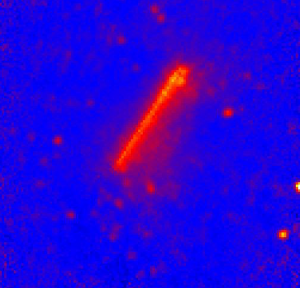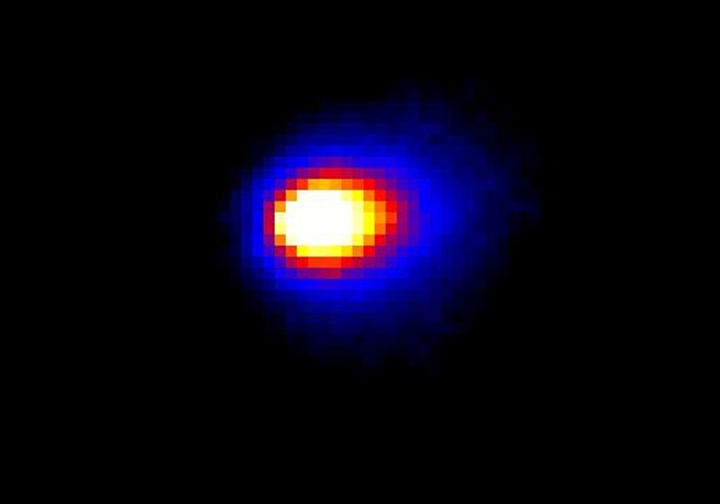| Basic Information | |
| What is this? | Comet Hartley 2 |
| Where is it in the sky? | Orbiting the Sun about once every 6.5 years |
| How big is it? | The nucleus of the comet is just 2 km in diameter but its atmosphere, or coma, is much larger |
| How far away is it? | The comet passed just 16.4 million km from Herschel |
| What do the colours represent? | The cred and white show brighteest emission by water, gas and dust being from the comet |
Downloads
See this object in:
In the period 24 October to 17 November 2010 Herschel used its complement of state-of-the-art instruments to observe the far-infrared and submillimetre spectrum and to image the thermal dust radiation of comet 103P/Hartley 2, covering the 55-671 μm spectral range. Herschel is taking part in an extraordinary worldwide astronomical campaign to study comet Hartley 2 before, during, and after the flyby the NASA’s Deep Impact spacecraft on 4 November 2010 as part of its EPOXI mission.
This return of comet Hartley 2 in 2010 was exceptional. The comet was at “perihelion”, meaning closest to the Sun, on 28th October and passed just 18 million km from the Earth on 20th October, making this closest approach to the Earth since its discovery in 1986 and by far its closest approach in the next century. Comet Hartley 2 passed 16.4 million km from Herschel on October 20, providing an opportunity to acquire sensitive measurements, complementary to the observations from EPOXI and other telescopes and spacecraft. The early Herschel observations of comet Hartley 2 demonstrated the observatory’s unique capabilities: sensitive far-infrared images constrained the size of the large dust particles, and spectra reveal the distribution of water molecules released from the nucleus as the ices evaporate when the comet approaches the Sun. From these measurements, it is calculated that the comet is losing about 230 kg of water every second. The emission from water is constrained using observations of high-excitation rotational water transitions using the three Herschel instruments: HIFI, SPIRE and PACS. All three instruments detect the presence of water, and HIFI is sensitive enough to measure its velocity. PACS also provides images of the dust and water emission at the time of the EPOXI flyby.

“The SPIRE observations represent the first imaging of a comet at these wavelengths”, said Prof. Dr. Bruce Swinyard, team member and scientist from the University College London in the UK. Dr. Dominique Bockelée-Morvan, from LESIA in France, said “observations of the dust coma with PACS and SPIRE allow us to constrain properties of the large dust particles and to measure the dust production rate”.
The image on the right shows the view of Comet Hartley 2 as seen by the SPIRE instrument, moving relative to the background galaxies. The fast movement of comet Hartley 2, the constraints caused by the direct sunlight heating of the telescope’s star trackers, and the need to schedule observations with multiple instruments during the same day required detailed planning for this campaign by the Herschel Mission Planning Team. Thanks to all these efforts, Herschel observed Hartley 2 in fantastic detail in support of the EPOXI flyby event. The observations reported here are part of the Herschel Guaranteed Time Key program “Water and related chemistry in the Solar System” (HssO), which includes an international team of scientists led by Principal Investigator Dr. Paul Hartogh (Max-Planck-Institut für Sonnensystemforschung, Germany).



